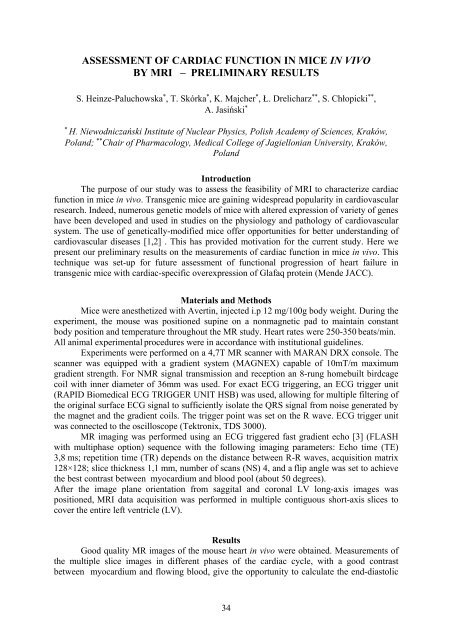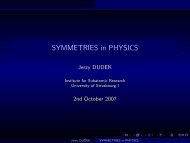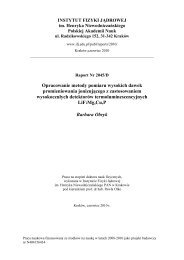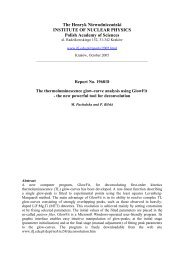Report No xxxx - Instytut Fizyki JÄ drowej PAN
Report No xxxx - Instytut Fizyki JÄ drowej PAN
Report No xxxx - Instytut Fizyki JÄ drowej PAN
You also want an ePaper? Increase the reach of your titles
YUMPU automatically turns print PDFs into web optimized ePapers that Google loves.
ASSESSMENT OF CARDIAC FUNCTION IN MICE IN VIVO<br />
BY MRI – PRELIMINARY RESULTS<br />
S. Heinze-Paluchowska ∗ , T. Skórka ∗ , K. Majcher ∗ , Ł. Drelicharz ∗∗ , S. Chłopicki ∗∗ ,<br />
A. Jasiński ∗<br />
∗<br />
H. Niewodniczański Institute of Nuclear Physics, Polish Academy of Sciences, Kraków,<br />
Poland; ∗∗ Chair of Pharmacology, Medical College of Jagiellonian University, Kraków,<br />
Poland<br />
Introduction<br />
The purpose of our study was to assess the feasibility of MRI to characterize cardiac<br />
function in mice in vivo. Transgenic mice are gaining widespread popularity in cardiovascular<br />
research. Indeed, numerous genetic models of mice with altered expression of variety of genes<br />
have been developed and used in studies on the physiology and pathology of cardiovascular<br />
system. The use of genetically-modified mice offer opportunities for better understanding of<br />
cardiovascular diseases [1,2] . This has provided motivation for the current study. Here we<br />
present our preliminary results on the measurements of cardiac function in mice in vivo. This<br />
technique was set-up for future assessment of functional progression of heart failure in<br />
transgenic mice with cardiac-specific overexpression of Glafaq protein (Mende JACC).<br />
Materials and Methods<br />
Mice were anesthetized with Avertin, injected i.p 12 mg/100g body weight. During the<br />
experiment, the mouse was positioned supine on a nonmagnetic pad to maintain constant<br />
body position and temperature throughout the MR study. Heart rates were 250-350 beats/min.<br />
All animal experimental procedures were in accordance with institutional guidelines.<br />
Experiments were performed on a 4,7T MR scanner with MARAN DRX console. The<br />
scanner was equipped with a gradient system (MAGNEX) capable of 10mT/m maximum<br />
gradient strength. For NMR signal transmission and reception an 8-rung homebuilt birdcage<br />
coil with inner diameter of 36mm was used. For exact ECG triggering, an ECG trigger unit<br />
(RAPID Biomedical ECG TRIGGER UNIT HSB) was used, allowing for multiple filtering of<br />
the original surface ECG signal to sufficiently isolate the QRS signal from noise generated by<br />
the magnet and the gradient coils. The trigger point was set on the R wave. ECG trigger unit<br />
was connected to the oscilloscope (Tektronix, TDS 3000).<br />
MR imaging was performed using an ECG triggered fast gradient echo [3] (FLASH<br />
with multiphase option) sequence with the following imaging parameters: Echo time (TE)<br />
3,8 ms; repetition time (TR) depends on the distance between R-R waves, acquisition matrix<br />
128×128; slice thickness 1,1 mm, number of scans (NS) 4, and a flip angle was set to achieve<br />
the best contrast between myocardium and blood pool (about 50 degrees).<br />
After the image plane orientation from saggital and coronal LV long-axis images was<br />
positioned, MRI data acquisition was performed in multiple contiguous short-axis slices to<br />
cover the entire left ventricle (LV).<br />
Results<br />
Good quality MR images of the mouse heart in vivo were obtained. Measurements of<br />
the multiple slice images in different phases of the cardiac cycle, with a good contrast<br />
between myocardium and flowing blood, give the opportunity to calculate the end-diastolic<br />
34

















